Refine search
No keyword found to refine search
keywords EN
Places
Names
440 documents found
| 1 | 8 |
Documents per page :

Illustrative pictures of Lithuania
Jan Schmidt-Whitley/Le Pictorium
LePictorium_0289281.jpg
Traditional wooden house in the city of Vilnius. Lithuania's capital still boasts a large number of wooden houses, which have recently become relatively popular, and efforts have been made by the local authorities to preserve this heritage.

Illustrative pictures of Lithuania
Jan Schmidt-Whitley/Le Pictorium
LePictorium_0289283.jpg
Traditional wooden house in the city of Vilnius. Lithuania's capital still boasts a large number of wooden houses, which have recently become relatively popular, and efforts have been made by the local authorities to preserve this heritage.
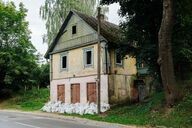
Illustrative pictures of Lithuania
Jan Schmidt-Whitley/Le Pictorium
LePictorium_0289284.jpg
Traditional wooden house in the city of Vilnius. Lithuania's capital still boasts a large number of wooden houses, which have recently become relatively popular, and efforts have been made by the local authorities to preserve this heritage.
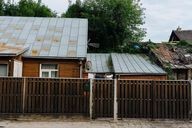
Illustrative pictures of Lithuania
Jan Schmidt-Whitley/Le Pictorium
LePictorium_0289285.jpg
Traditional wooden house in the city of Vilnius. Lithuania's capital still boasts a large number of wooden houses, which have recently become relatively popular, and efforts have been made by the local authorities to preserve this heritage.
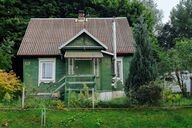
Illustrative pictures of Lithuania
Jan Schmidt-Whitley/Le Pictorium
LePictorium_0289287.jpg
Traditional wooden house in the city of Vilnius. Lithuania's capital still boasts a large number of wooden houses, which have recently become relatively popular, and efforts have been made by the local authorities to preserve this heritage.

Illustrative pictures of Lithuania
Jan Schmidt-Whitley/Le Pictorium
LePictorium_0289326.jpg
A scene in the streets of Vilnius, in the centre of the old town, a UNESCO World Heritage site.
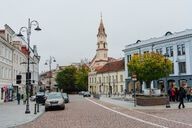
Illustrative pictures of Lithuania
Jan Schmidt-Whitley/Le Pictorium
LePictorium_0289328.jpg
A scene in the streets of Vilnius, in the centre of the old town, a UNESCO World Heritage site.

Illustrative pictures of Lithuania
Jan Schmidt-Whitley/Le Pictorium
LePictorium_0289387.jpg
A scene in the streets of Vilnius, in the centre of the old town, a UNESCO World Heritage site.
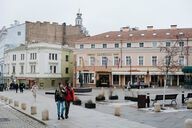
Illustrative pictures of Lithuania
Jan Schmidt-Whitley/Le Pictorium
LePictorium_0289399.jpg
A scene in the streets of Vilnius, in the centre of the old town, a UNESCO World Heritage site.

Illustrative pictures of Lithuania
Jan Schmidt-Whitley/Le Pictorium
LePictorium_0289401.jpg
A scene in the streets of Vilnius, in the centre of the old town, a UNESCO World Heritage site.

The city and the Mosque of Djenne in Mali.
Nicolas Réméné / Le Pictorium
LePictorium_0278107.jpg
The city of Djenné is located in the Inner Niger Delta in Mali about 580 kilometers from Bamako. Djenné is built between two arms of the Bani, a tributary of the Niger. The buildings are constructed in banco. and the specific architecture of the city of Djenné allowed the inscription in 1988 of this city on the list of the world heritage of UNESCO. The great mosque of Djenné built from 1906 and with Sahelo-Sudanese architecture is the largest building in the world built in raw earth. (Adobe).
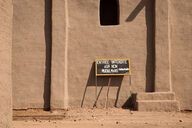
The city and the Mosque of Djenne in Mali.
Nicolas Réméné / Le Pictorium
LePictorium_0278108.jpg
The city of Djenné is located in the Inner Niger Delta in Mali about 580 kilometers from Bamako. Djenné is built between two arms of the Bani, a tributary of the Niger. The buildings are constructed in banco. and the specific architecture of the city of Djenné allowed the inscription in 1988 of this city on the list of the world heritage of UNESCO. The great mosque of Djenné built from 1906 and with Sahelo-Sudanese architecture is the largest building in the world built in raw earth. (Adobe).
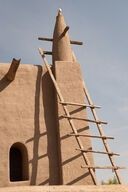
The city and the Mosque of Djenne in Mali.
Nicolas Réméné / Le Pictorium
LePictorium_0278109.jpg
The city of Djenné is located in the Inner Niger Delta in Mali about 580 kilometers from Bamako. Djenné is built between two arms of the Bani, a tributary of the Niger. The buildings are constructed in banco. and the specific architecture of the city of Djenné allowed the inscription in 1988 of this city on the list of the world heritage of UNESCO. The great mosque of Djenné built from 1906 and with Sahelo-Sudanese architecture is the largest building in the world built in raw earth. (Adobe).
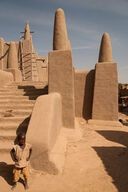
The city and the Mosque of Djenne in Mali.
Nicolas Réméné / Le Pictorium
LePictorium_0278110.jpg
The city of Djenné is located in the Inner Niger Delta in Mali about 580 kilometers from Bamako. Djenné is built between two arms of the Bani, a tributary of the Niger. The buildings are constructed in banco. and the specific architecture of the city of Djenné allowed the inscription in 1988 of this city on the list of the world heritage of UNESCO. The great mosque of Djenné built from 1906 and with Sahelo-Sudanese architecture is the largest building in the world built in raw earth. (Adobe).
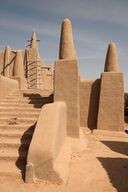
The city and the Mosque of Djenne in Mali.
Nicolas Réméné / Le Pictorium
LePictorium_0278111.jpg
The city of Djenné is located in the Inner Niger Delta in Mali about 580 kilometers from Bamako. Djenné is built between two arms of the Bani, a tributary of the Niger. The buildings are constructed in banco. and the specific architecture of the city of Djenné allowed the inscription in 1988 of this city on the list of the world heritage of UNESCO. The great mosque of Djenné built from 1906 and with Sahelo-Sudanese architecture is the largest building in the world built in raw earth. (Adobe).
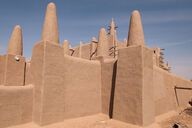
The city and the Mosque of Djenne in Mali.
Nicolas Réméné / Le Pictorium
LePictorium_0278112.jpg
The city of Djenné is located in the Inner Niger Delta in Mali about 580 kilometers from Bamako. Djenné is built between two arms of the Bani, a tributary of the Niger. The buildings are constructed in banco. and the specific architecture of the city of Djenné allowed the inscription in 1988 of this city on the list of the world heritage of UNESCO. The great mosque of Djenné built from 1906 and with Sahelo-Sudanese architecture is the largest building in the world built in raw earth. (Adobe).

The city and the Mosque of Djenne in Mali.
Nicolas Réméné / Le Pictorium
LePictorium_0278113.jpg
The city of Djenné is located in the Inner Niger Delta in Mali about 580 kilometers from Bamako. Djenné is built between two arms of the Bani, a tributary of the Niger. The buildings are constructed in banco. and the specific architecture of the city of Djenné allowed the inscription in 1988 of this city on the list of the world heritage of UNESCO. The great mosque of Djenné built from 1906 and with Sahelo-Sudanese architecture is the largest building in the world built in raw earth. (Adobe).
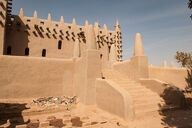
The city and the Mosque of Djenne in Mali.
Nicolas Réméné / Le Pictorium
LePictorium_0278114.jpg
The city of Djenné is located in the Inner Niger Delta in Mali about 580 kilometers from Bamako. Djenné is built between two arms of the Bani, a tributary of the Niger. The buildings are constructed in banco. and the specific architecture of the city of Djenné allowed the inscription in 1988 of this city on the list of the world heritage of UNESCO. The great mosque of Djenné built from 1906 and with Sahelo-Sudanese architecture is the largest building in the world built in raw earth. (Adobe).
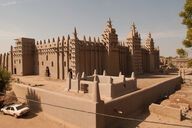
The city and the Mosque of Djenne in Mali.
Nicolas Réméné / Le Pictorium
LePictorium_0278115.jpg
The city of Djenné is located in the Inner Niger Delta in Mali about 580 kilometers from Bamako. Djenné is built between two arms of the Bani, a tributary of the Niger. The buildings are constructed in banco. and the specific architecture of the city of Djenné allowed the inscription in 1988 of this city on the list of the world heritage of UNESCO. The great mosque of Djenné built from 1906 and with Sahelo-Sudanese architecture is the largest building in the world built in raw earth. (Adobe).
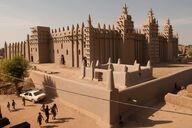
The city and the Mosque of Djenne in Mali.
Nicolas Réméné / Le Pictorium
LePictorium_0278116.jpg
The city of Djenné is located in the Inner Niger Delta in Mali about 580 kilometers from Bamako. Djenné is built between two arms of the Bani, a tributary of the Niger. The buildings are constructed in banco. and the specific architecture of the city of Djenné allowed the inscription in 1988 of this city on the list of the world heritage of UNESCO. The great mosque of Djenné built from 1906 and with Sahelo-Sudanese architecture is the largest building in the world built in raw earth. (Adobe).

The city and the Mosque of Djenne in Mali.
Nicolas Réméné / Le Pictorium
LePictorium_0278117.jpg
The city of Djenné is located in the Inner Niger Delta in Mali about 580 kilometers from Bamako. Djenné is built between two arms of the Bani, a tributary of the Niger. The buildings are constructed in banco. and the specific architecture of the city of Djenné allowed the inscription in 1988 of this city on the list of the world heritage of UNESCO. The great mosque of Djenné built from 1906 and with Sahelo-Sudanese architecture is the largest building in the world built in raw earth. (Adobe).
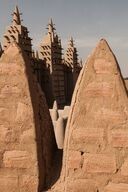
The city and the Mosque of Djenne in Mali.
Nicolas Réméné / Le Pictorium
LePictorium_0278118.jpg
The city of Djenné is located in the Inner Niger Delta in Mali about 580 kilometers from Bamako. Djenné is built between two arms of the Bani, a tributary of the Niger. The buildings are constructed in banco. and the specific architecture of the city of Djenné allowed the inscription in 1988 of this city on the list of the world heritage of UNESCO. The great mosque of Djenné built from 1906 and with Sahelo-Sudanese architecture is the largest building in the world built in raw earth. (Adobe).
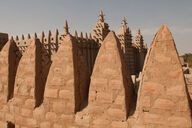
The city and the Mosque of Djenne in Mali.
Nicolas Réméné / Le Pictorium
LePictorium_0278119.jpg
The city of Djenné is located in the Inner Niger Delta in Mali about 580 kilometers from Bamako. Djenné is built between two arms of the Bani, a tributary of the Niger. The buildings are constructed in banco. and the specific architecture of the city of Djenné allowed the inscription in 1988 of this city on the list of the world heritage of UNESCO. The great mosque of Djenné built from 1906 and with Sahelo-Sudanese architecture is the largest building in the world built in raw earth. (Adobe).
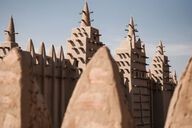
The city and the Mosque of Djenne in Mali.
Nicolas Réméné / Le Pictorium
LePictorium_0278120.jpg
The city of Djenné is located in the Inner Niger Delta in Mali about 580 kilometers from Bamako. Djenné is built between two arms of the Bani, a tributary of the Niger. The buildings are constructed in banco. and the specific architecture of the city of Djenné allowed the inscription in 1988 of this city on the list of the world heritage of UNESCO. The great mosque of Djenné built from 1906 and with Sahelo-Sudanese architecture is the largest building in the world built in raw earth. (Adobe).
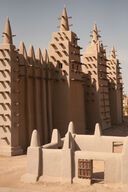
The city and the Mosque of Djenne in Mali.
Nicolas Réméné / Le Pictorium
LePictorium_0278121.jpg
The city of Djenné is located in the Inner Niger Delta in Mali about 580 kilometers from Bamako. Djenné is built between two arms of the Bani, a tributary of the Niger. The buildings are constructed in banco. and the specific architecture of the city of Djenné allowed the inscription in 1988 of this city on the list of the world heritage of UNESCO. The great mosque of Djenné built from 1906 and with Sahelo-Sudanese architecture is the largest building in the world built in raw earth. (Adobe).
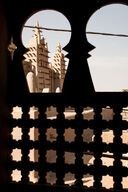
The city and the Mosque of Djenne in Mali.
Nicolas Réméné / Le Pictorium
LePictorium_0278122.jpg
The city of Djenné is located in the Inner Niger Delta in Mali about 580 kilometers from Bamako. Djenné is built between two arms of the Bani, a tributary of the Niger. The buildings are constructed in banco. and the specific architecture of the city of Djenné allowed the inscription in 1988 of this city on the list of the world heritage of UNESCO. The great mosque of Djenné built from 1906 and with Sahelo-Sudanese architecture is the largest building in the world built in raw earth. (Adobe).
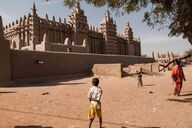
The city and the Mosque of Djenne in Mali.
Nicolas Réméné / Le Pictorium
LePictorium_0278123.jpg
The city of Djenné is located in the Inner Niger Delta in Mali about 580 kilometers from Bamako. Djenné is built between two arms of the Bani, a tributary of the Niger. The buildings are constructed in banco. and the specific architecture of the city of Djenné allowed the inscription in 1988 of this city on the list of the world heritage of UNESCO. The great mosque of Djenné built from 1906 and with Sahelo-Sudanese architecture is the largest building in the world built in raw earth. (Adobe).
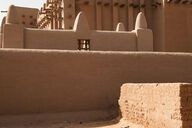
The city and the Mosque of Djenne in Mali.
Nicolas Réméné / Le Pictorium
LePictorium_0278124.jpg
The city of Djenné is located in the Inner Niger Delta in Mali about 580 kilometers from Bamako. Djenné is built between two arms of the Bani, a tributary of the Niger. The buildings are constructed in banco. and the specific architecture of the city of Djenné allowed the inscription in 1988 of this city on the list of the world heritage of UNESCO. The great mosque of Djenné built from 1906 and with Sahelo-Sudanese architecture is the largest building in the world built in raw earth. (Adobe).
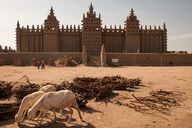
The city and the Mosque of Djenne in Mali.
Nicolas Réméné / Le Pictorium
LePictorium_0278125.jpg
The city of Djenné is located in the Inner Niger Delta in Mali about 580 kilometers from Bamako. Djenné is built between two arms of the Bani, a tributary of the Niger. The buildings are constructed in banco. and the specific architecture of the city of Djenné allowed the inscription in 1988 of this city on the list of the world heritage of UNESCO. The great mosque of Djenné built from 1906 and with Sahelo-Sudanese architecture is the largest building in the world built in raw earth. (Adobe).
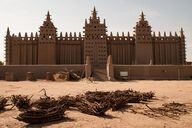
The city and the Mosque of Djenne in Mali.
Nicolas Réméné / Le Pictorium
LePictorium_0278126.jpg
The city of Djenné is located in the Inner Niger Delta in Mali about 580 kilometers from Bamako. Djenné is built between two arms of the Bani, a tributary of the Niger. The buildings are constructed in banco. and the specific architecture of the city of Djenné allowed the inscription in 1988 of this city on the list of the world heritage of UNESCO. The great mosque of Djenné built from 1906 and with Sahelo-Sudanese architecture is the largest building in the world built in raw earth. (Adobe).

The city and the Mosque of Djenne in Mali.
Nicolas Réméné / Le Pictorium
LePictorium_0278127.jpg
The city of Djenné is located in the Inner Niger Delta in Mali about 580 kilometers from Bamako. Djenné is built between two arms of the Bani, a tributary of the Niger. The buildings are constructed in banco. and the specific architecture of the city of Djenné allowed the inscription in 1988 of this city on the list of the world heritage of UNESCO. The great mosque of Djenné built from 1906 and with Sahelo-Sudanese architecture is the largest building in the world built in raw earth. (Adobe).
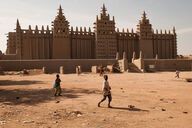
The city and the Mosque of Djenne in Mali.
Nicolas Réméné / Le Pictorium
LePictorium_0278128.jpg
The city of Djenné is located in the Inner Niger Delta in Mali about 580 kilometers from Bamako. Djenné is built between two arms of the Bani, a tributary of the Niger. The buildings are constructed in banco. and the specific architecture of the city of Djenné allowed the inscription in 1988 of this city on the list of the world heritage of UNESCO. The great mosque of Djenné built from 1906 and with Sahelo-Sudanese architecture is the largest building in the world built in raw earth. (Adobe).
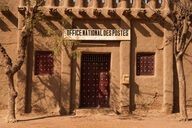
The city and the Mosque of Djenne in Mali.
Nicolas Réméné / Le Pictorium
LePictorium_0278129.jpg
The city of Djenné is located in the Inner Niger Delta in Mali about 580 kilometers from Bamako. Djenné is built between two arms of the Bani, a tributary of the Niger. The buildings are constructed in banco. and the specific architecture of the city of Djenné allowed the inscription in 1988 of this city on the list of the world heritage of UNESCO. The great mosque of Djenné built from 1906 and with Sahelo-Sudanese architecture is the largest building in the world built in raw earth. (Adobe).
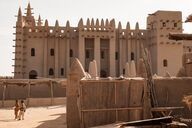
The city and the Mosque of Djenne in Mali.
Nicolas Réméné / Le Pictorium
LePictorium_0278130.jpg
The city of Djenné is located in the Inner Niger Delta in Mali about 580 kilometers from Bamako. Djenné is built between two arms of the Bani, a tributary of the Niger. The buildings are constructed in banco. and the specific architecture of the city of Djenné allowed the inscription in 1988 of this city on the list of the world heritage of UNESCO. The great mosque of Djenné built from 1906 and with Sahelo-Sudanese architecture is the largest building in the world built in raw earth. (Adobe).
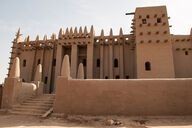
The city and the Mosque of Djenne in Mali.
Nicolas Réméné / Le Pictorium
LePictorium_0278131.jpg
The city of Djenné is located in the Inner Niger Delta in Mali about 580 kilometers from Bamako. Djenné is built between two arms of the Bani, a tributary of the Niger. The buildings are constructed in banco. and the specific architecture of the city of Djenné allowed the inscription in 1988 of this city on the list of the world heritage of UNESCO. The great mosque of Djenné built from 1906 and with Sahelo-Sudanese architecture is the largest building in the world built in raw earth. (Adobe).

The city and the Mosque of Djenne in Mali.
Nicolas Réméné / Le Pictorium
LePictorium_0278132.jpg
The city of Djenné is located in the Inner Niger Delta in Mali about 580 kilometers from Bamako. Djenné is built between two arms of the Bani, a tributary of the Niger. The buildings are constructed in banco. and the specific architecture of the city of Djenné allowed the inscription in 1988 of this city on the list of the world heritage of UNESCO. The great mosque of Djenné built from 1906 and with Sahelo-Sudanese architecture is the largest building in the world built in raw earth. (Adobe).
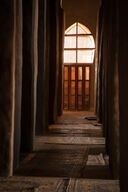
The city and the Mosque of Djenne in Mali.
Nicolas Réméné / Le Pictorium
LePictorium_0278133.jpg
The city of Djenné is located in the Inner Niger Delta in Mali about 580 kilometers from Bamako. Djenné is built between two arms of the Bani, a tributary of the Niger. The buildings are constructed in banco. and the specific architecture of the city of Djenné allowed the inscription in 1988 of this city on the list of the world heritage of UNESCO. The great mosque of Djenné built from 1906 and with Sahelo-Sudanese architecture is the largest building in the world built in raw earth. (Adobe).

The city and the Mosque of Djenne in Mali.
Nicolas Réméné / Le Pictorium
LePictorium_0278134.jpg
The city of Djenné is located in the Inner Niger Delta in Mali about 580 kilometers from Bamako. Djenné is built between two arms of the Bani, a tributary of the Niger. The buildings are constructed in banco. and the specific architecture of the city of Djenné allowed the inscription in 1988 of this city on the list of the world heritage of UNESCO. The great mosque of Djenné built from 1906 and with Sahelo-Sudanese architecture is the largest building in the world built in raw earth. (Adobe).
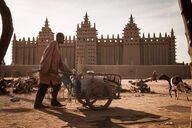
The city and the Mosque of Djenne in Mali.
Nicolas Réméné / Le Pictorium
LePictorium_0278135.jpg
The city of Djenné is located in the Inner Niger Delta in Mali about 580 kilometers from Bamako. Djenné is built between two arms of the Bani, a tributary of the Niger. The buildings are constructed in banco. and the specific architecture of the city of Djenné allowed the inscription in 1988 of this city on the list of the world heritage of UNESCO. The great mosque of Djenné built from 1906 and with Sahelo-Sudanese architecture is the largest building in the world built in raw earth. (Adobe).
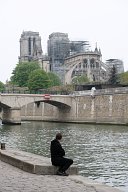
Fire of Notre-Dame de Paris - The day after
Laurent Paillier / Le Pictorium
LePictorium_0206319.jpg
The day after the fire at Notre-Dame Cathedral in Paris, it is time to evaluate and assess the damage. Firefighters and experts are busy around the monument while the crowd of onlookers crowds with recollection and disbelief.
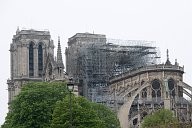
Fire of Notre-Dame de Paris - The day after
Laurent Paillier / Le Pictorium
LePictorium_0206320.jpg
The day after the fire at Notre-Dame Cathedral in Paris, it is time to evaluate and assess the damage. Firefighters and experts are busy around the monument while the crowd of onlookers crowds with recollection and disbelief.

Fire of Notre-Dame de Paris - The day after
Laurent Paillier / Le Pictorium
LePictorium_0206321.jpg
The day after the fire at Notre-Dame Cathedral in Paris, it is time to evaluate and assess the damage. Firefighters and experts are busy around the monument while the crowd of onlookers crowds with recollection and disbelief.
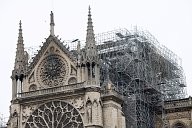
Fire of Notre-Dame de Paris - The day after
Laurent Paillier / Le Pictorium
LePictorium_0206322.jpg
The day after the fire at Notre-Dame Cathedral in Paris, it is time to evaluate and assess the damage. Firefighters and experts are busy around the monument while the crowd of onlookers crowds with recollection and disbelief.
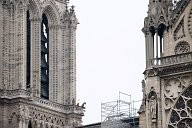
Fire of Notre-Dame de Paris - The day after
Laurent Paillier / Le Pictorium
LePictorium_0206323.jpg
The day after the fire at Notre-Dame Cathedral in Paris, it is time to evaluate and assess the damage. Firefighters and experts are busy around the monument while the crowd of onlookers crowds with recollection and disbelief.
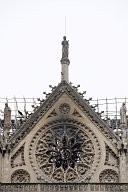
Fire of Notre-Dame de Paris - The day after
Laurent Paillier / Le Pictorium
LePictorium_0206324.jpg
The day after the fire at Notre-Dame Cathedral in Paris, it is time to evaluate and assess the damage. Firefighters and experts are busy around the monument while the crowd of onlookers crowds with recollection and disbelief.
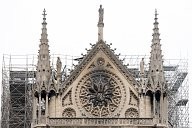
Fire of Notre-Dame de Paris - The day after
Laurent Paillier / Le Pictorium
LePictorium_0206325.jpg
The day after the fire at Notre-Dame Cathedral in Paris, it is time to evaluate and assess the damage. Firefighters and experts are busy around the monument while the crowd of onlookers crowds with recollection and disbelief.
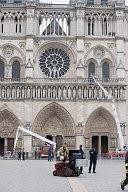
Fire of Notre-Dame de Paris - The day after
Laurent Paillier / Le Pictorium
LePictorium_0206326.jpg
The day after the fire at Notre-Dame Cathedral in Paris, it is time to evaluate and assess the damage. Firefighters and experts are busy around the monument while the crowd of onlookers crowds with recollection and disbelief.
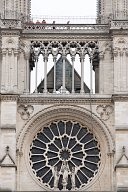
Fire of Notre-Dame de Paris - The day after
Laurent Paillier / Le Pictorium
LePictorium_0206327.jpg
The day after the fire at Notre-Dame Cathedral in Paris, it is time to evaluate and assess the damage. Firefighters and experts are busy around the monument while the crowd of onlookers crowds with recollection and disbelief.
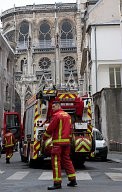
Fire of Notre-Dame de Paris - The day after
Laurent Paillier / Le Pictorium
LePictorium_0206328.jpg
The day after the fire at Notre-Dame Cathedral in Paris, it is time to evaluate and assess the damage. Firefighters and experts are busy around the monument while the crowd of onlookers crowds with recollection and disbelief.
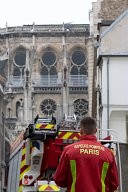
Fire of Notre-Dame de Paris - The day after
Laurent Paillier / Le Pictorium
LePictorium_0206329.jpg
The day after the fire at Notre-Dame Cathedral in Paris, it is time to evaluate and assess the damage. Firefighters and experts are busy around the monument while the crowd of onlookers crowds with recollection and disbelief.
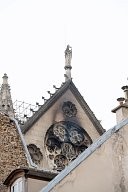
Fire of Notre-Dame de Paris - The day after
Laurent Paillier / Le Pictorium
LePictorium_0206330.jpg
The day after the fire at Notre-Dame Cathedral in Paris, it is time to evaluate and assess the damage. Firefighters and experts are busy around the monument while the crowd of onlookers crowds with recollection and disbelief.
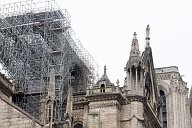
Fire of Notre-Dame de Paris - The day after
Laurent Paillier / Le Pictorium
LePictorium_0206331.jpg
The day after the fire at Notre-Dame Cathedral in Paris, it is time to evaluate and assess the damage. Firefighters and experts are busy around the monument while the crowd of onlookers crowds with recollection and disbelief.

Fire of Notre-Dame de Paris - The day after
Laurent Paillier / Le Pictorium
LePictorium_0206332.jpg
François de Rugy, the Minister of Ecology. The day after the fire at Notre-Dame Cathedral in Paris, it is time to evaluate and assess the damage. Firefighters and experts are busy around the monument while the crowd of onlookers crowds with recollection and disbelief.
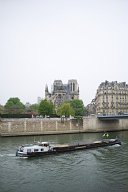
Fire of Notre-Dame de Paris - The day after
Laurent Paillier / Le Pictorium
LePictorium_0206333.jpg
The day after the fire at Notre-Dame Cathedral in Paris, it is time to evaluate and assess the damage. Firefighters and experts are busy around the monument while the crowd of onlookers crowds with recollection and disbelief.
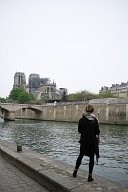
Fire of Notre-Dame de Paris - The day after
Laurent Paillier / Le Pictorium
LePictorium_0206334.jpg
The day after the fire at Notre-Dame Cathedral in Paris, it is time to evaluate and assess the damage. Firefighters and experts are busy around the monument while the crowd of onlookers crowds with recollection and disbelief.
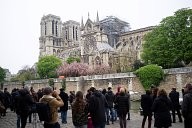
Fire of Notre-Dame de Paris - The day after
Laurent Paillier / Le Pictorium
LePictorium_0206335.jpg
The day after the fire at Notre-Dame Cathedral in Paris, it is time to evaluate and assess the damage. Firefighters and experts are busy around the monument while the crowd of onlookers crowds with recollection and disbelief.
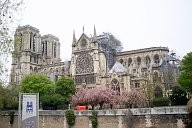
Fire of Notre-Dame de Paris - The day after
Laurent Paillier / Le Pictorium
LePictorium_0206336.jpg
The day after the fire at Notre-Dame Cathedral in Paris, it is time to evaluate and assess the damage. Firefighters and experts are busy around the monument while the crowd of onlookers crowds with recollection and disbelief.
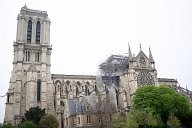
Fire of Notre-Dame de Paris - The day after
Laurent Paillier / Le Pictorium
LePictorium_0206337.jpg
The day after the fire at Notre-Dame Cathedral in Paris, it is time to evaluate and assess the damage. Firefighters and experts are busy around the monument while the crowd of onlookers crowds with recollection and disbelief.
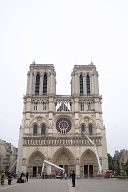
Fire of Notre-Dame de Paris - The day after
Laurent Paillier / Le Pictorium
LePictorium_0206338.jpg
The day after the fire at Notre-Dame Cathedral in Paris, it is time to evaluate and assess the damage. Firefighters and experts are busy around the monument while the crowd of onlookers crowds with recollection and disbelief.
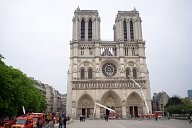
Fire of Notre-Dame de Paris - The day after
Laurent Paillier / Le Pictorium
LePictorium_0206339.jpg
The day after the fire at Notre-Dame Cathedral in Paris, it is time to evaluate and assess the damage. Firefighters and experts are busy around the monument while the crowd of onlookers crowds with recollection and disbelief.
Next page
